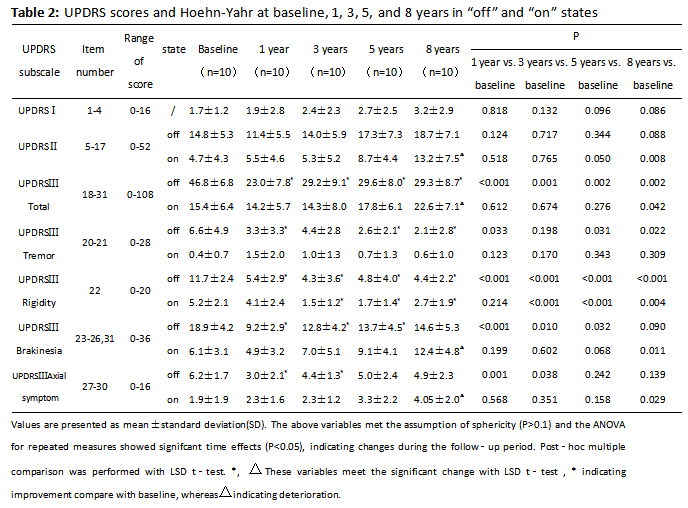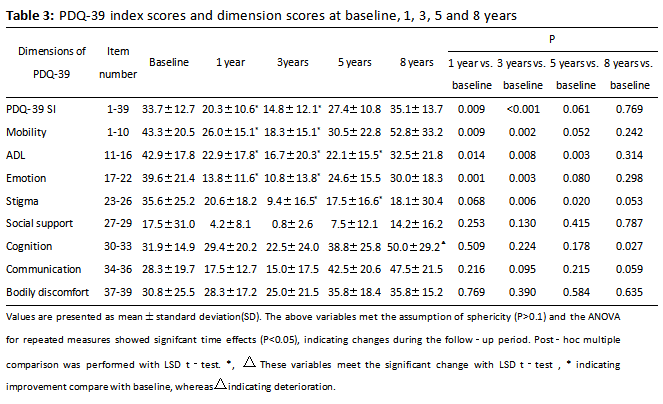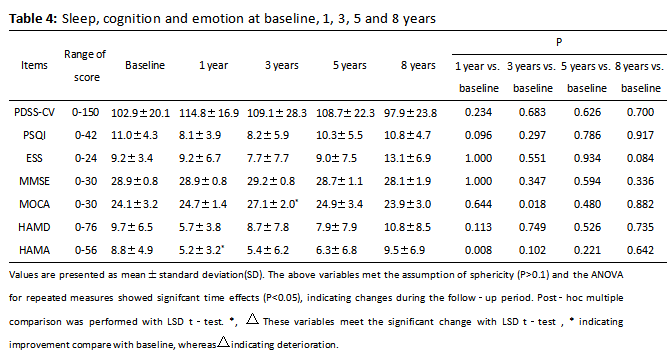Session Information
Date: Saturday, October 6, 2018
Session Title: Surgical Therapy: Parkinson's Disease
Session Time: 1:45pm-3:15pm
Location: Hall 3FG
Objective: To investigate the long term efficacy and its safety of STN DBS for PD in China with an eight years follow up of ten patients.
Background: Parkinson’s disease( PD ) is a neurodegenerative disease. With the progression of the disease, the symptoms gradually worsen and levodopa-induced motor complications arose. Deep brain stimulation( DBS ) is an effective treatment for advanced PD. There are some RCT researches for short term efficacy for DBS as well as some long term studies in foreign. But its long term efficacy has been little reported in China, although China occupies the largest proportion of PD patients.
Methods: Patients with PD who had recieved bilateral STN DBS, was assessed preoperatively(baseline) and 1, 3, 5 and 8 years postoperatively on medication and without medication, using the Unified Parkinson’s disease Rating Scale (UPDRS) and a series of neuropsychological assessment. At the same time, the levodopa equivalent daily dose (LEDD) and stimulating parameters were also recorded.
Results: As compare to the preoperative med-off state, motor symptom improved by 37.3% ( P = 0.002). Among these, rigidity and tremor showed the most prominent improvement, and then follow by bradykinesia, axial symptom. As to the med-on state, motor symptom did not show significant change. The quality of life improved by 39.7%, 56.1%, 18.8% (P < 0.001)at 1, 3, and 5 years separately, but deteriorated at 8 years(-4.1%). Sleep, cognition, and emotion were mostly unchanged. Levodopa equivalent daily dose was reduced from 708.1±172.5 mg at baseline to 330±207.8 mg at 8 years (by 53.4%, P < 0.001). The stimulating parameter gradually increased and its stimulating pattern has changed from monopolar to bipolar and interleaving.
Conclusions: STN DBS showed a positive efficacy for advanced PD, appearing as improving motor symptoms and reducing more than half of the dosage of anti-PD medication. Patients’ quality of life showed an improvement till 5 years postoperatively. Compared with other studies, patients in our study received diverse stimulating setting which can better control patients’ symptom and less severe AEs was occurred.
To cite this abstract in AMA style:
Q. Guo, J. Liu, C. Yang, W. Xian, L. Jiang, S. Xu, W. Chen, Y. Hu, L. Chen. Long Term Outcome of the Subthalamic Nucleus DBS for Advanced Parkinson’s Disease: An Eight Years Follow-Up Study in China [abstract]. Mov Disord. 2018; 33 (suppl 2). https://www.mdsabstracts.org/abstract/long-term-outcome-of-the-subthalamic-nucleus-dbs-for-advanced-parkinsons-disease-an-eight-years-follow-up-study-in-china/. Accessed December 13, 2025.« Back to 2018 International Congress
MDS Abstracts - https://www.mdsabstracts.org/abstract/long-term-outcome-of-the-subthalamic-nucleus-dbs-for-advanced-parkinsons-disease-an-eight-years-follow-up-study-in-china/



